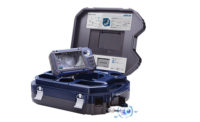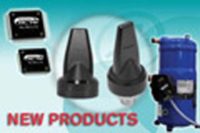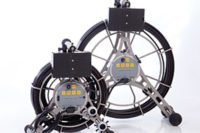Recently borescope manufacturers have been introducing high definition video borescopes to the market. It is important to understand the benefits of this new technology and what it will mean for your inspection program.
The new HD camera technology greatly improves the image resolution of video borescopes. Images show more detail and have a much crisper appearance. More pixels equate to more detail. Today manufacturers are labeling their video borescope high definition (HD) without defining what HD is compared to past generations of video borescopes. The last generation of video borescopes had images with a maximum of 440,000 pixels. An HD video borescope can increase image resolution from the previous generation by two or three times.
What makes a video borescope high definition “HD”? HD has typically been defined in the television world with terms like 720p (standard HD) or 1080p (Full HD). Video borescopes currently have competing definitions of 1024 x 768 (786,432 pixels) or 1280 x 960 (1,228,800 pixels). A 786,420 pixel image is double the resolution of standard video borescopes. However, the 1,228,800 pixel image is triple the resolution of a standard video borescope. For video borescopes the 786,432 image would be “standard HD” and the 1,228,800 image would be “full HD.”
Benefits of an HD video borescope include better image resolution, the ability to see more detail at greater distance, easier detection flaws, hairline cracks and more accurate measurement than ever before. HD video borescopes will also save time since inspections can be completed faster than ever with improved results. Measurement accuracy is also greatly improved with much greater reliability.
Image resolution has not advanced with video borescopes in a decade. The new HD and full HD video borescopes are providing images with as much as three times the detail as before. The improved image resolution allows for faster and easier detection of the smallest defect. Inspections of gas turbines, airframes, pipes, tubes and more are much improved. With increased resolution inspectors will locate defects that could not be seen before. The increased ability to see hairline cracks and other minute defects make the need for measurement even more critical.

Image resolution comparison

Measurement quality comparison
If there is a downside to the improvement in image resolution it is that you will now see more than ever before in great detail. The smallest defect no matter how insignificant will bring scrutiny that was not warranted in the past. The need to quickly and accurately measure defects will be more important than ever. Measurement allows inspectors to determine if a defect is within acceptable limits or not.
The new HD resolution of video borescopes will make measuring defects far more reliable. The increased resolution will have the added benefit of easier and more accurate measurements. More pixels enhance a video borescope’s accuracy. A standard HD video borescope can potentially double accuracy compared to previous generation video borescopes, while a full HD video borescope can effectively measure with triple the reliability.
Currently there are two primary methods of borescope measurement available: stereo and 3D phase. Three-dimensional phase measurement currently holds the advantage of being able to use all existing pixels to measure, while stereo is limited to only using half of all pixels to measure. When choosing which measurement method to pair with your borescope with it is important to understand what impact this will have on overall measurement reliability. When stereo measurement is paired with standard HD approximately 393,216 pixels are available. The optimal combination of full HD and 3D phase measurement makes available 1,228,800 pixels or greater than three times accuracy reliability.

HD borescope of gas turbine
Measurements with previous generation video borescopes could only be made to a maximum distance of 50mm. High definition video borescopes are able to see farther away in lower light conditions. This allows the video borescope to be positioned from a greater distance and maintain full accuracy. With a full HD video borescope that distance has increased to 105mm. This makes measurements of turbines and other critical assets far more reliable and easier to do.
Now that so many pixels are available with high definition video borescope zoom is possible without distortion of the image. Zoom has been a limited feature in the past because the individual pixels would be enlarged, and the image would lose too much detail to be useful. An HD video borescope now allows the imaged to be zoomed without any distortion. This ability allows more detailed inspection without having to move the tip of the video borescope closer.
Reports are now improved because images are saved with high quality resolution. In the past files needed to be compressed due to bandwidth issues, however, now files can be saved to reports without compression or pixilation. Improved modern processor speed generating the reports is now much faster. The ability to handle larger files sizes has been available with modern PCs and the internet for some time now and will be able to handle the enhanced reporting capability of the new HD video borescopes.

Full HD video borescope image
Image noise is caused by random brightness and color information, unwanted signals and the high sensitivity of a camera. Typically, image noise appears when viewing shiny or glossy surfaces or distant areas that are light starved. Noise reduction of images is now a standard feature common to HD video borescopes. Noise reduction cleans up images to provide the best possible clarity and quality image.
Wide fields of view with some tip optics can cause an image to appear to be curved at the edges or have a “fish eye” appearance. This distortion can be so great that the edges of turbine blades or other objects being inspected may appear bent. This effect may become even more pronounced with the higher resolutions of an HD video borescope. Distortion correction is the ability of the video borescope to automatically correct this and flatten the edges of the image. This allows the use of wide field of view tip optics without the inaccuracies.

HD borescope measurement
All new HD video borescopes are now including improved LCD displays. The new LCD displays allow for features like touch screens, brighter for use outdoors in sunlight and improved side viewing angles.
The benefits of upgrading to an HD or full HD video borescope will greatly improve any inspection program that relies on standard resolution video borescopes. Upgrading to standard HD will effectively double the resolution a standard resolution video borescope is capable of. Upgrading to full HD goes even further and triples the image resolution.
When an HD video borescope is paired with measurement the effect is to greatly increase measurement reliability. If the switch is made from a standard resolution video borescope to a full HD with 3D phase measurement reliability is improved by over 5X. This greatly improves any inspection program while reducing the time needed to perform inspections.

Full HD video borescope image
As more manufacturers introduce “HD” video borescopes it is important to understand what that really means for image resolution. A standard HD video borescope is a big improvement over the previous generation of video borescopes, however, full HD is an even bigger improvement. Upgrading to an HD borescope will improve any inspection program to meet the increased demand for reliability and safety in today’s world.



